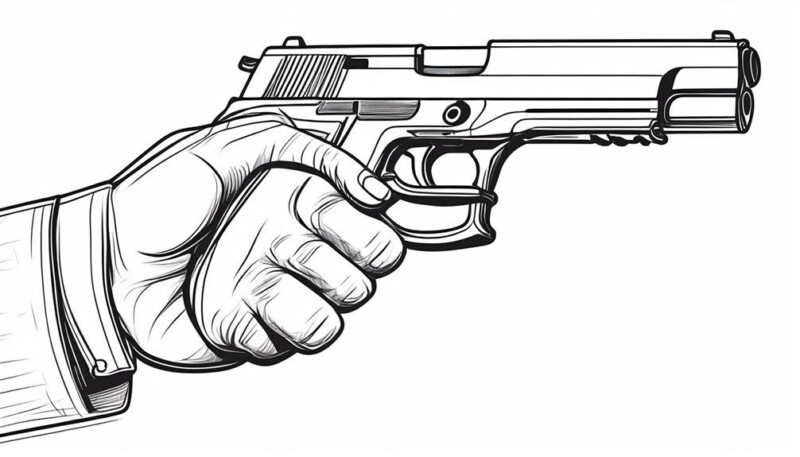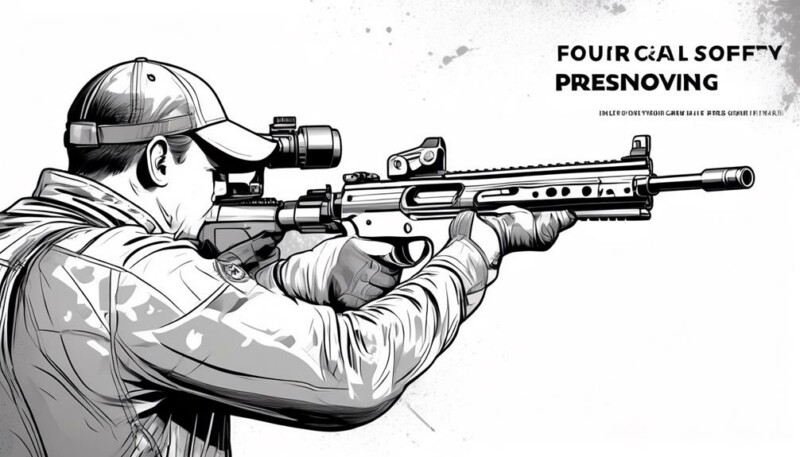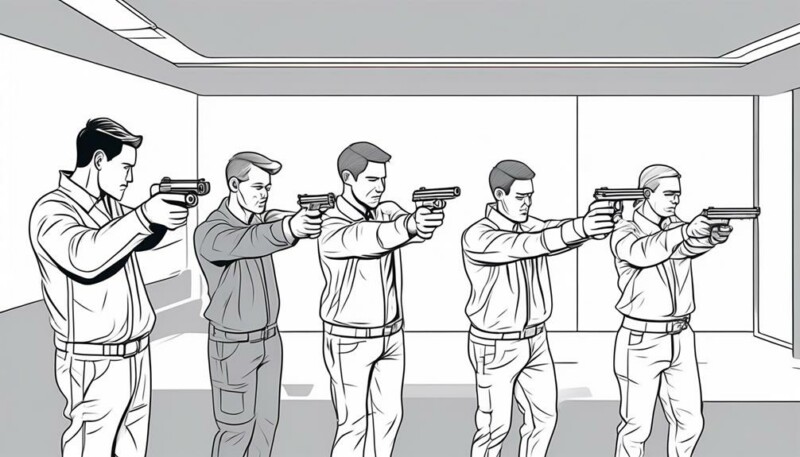Imagine you are embarking on a journey through the realm of firearm safety training, where knowledge and responsibility pave the way towards a secure and mindful approach to handling firearms.
As you take those first steps, it is crucial to equip yourself with the four basic tips that will serve as your compass, guiding you towards a safer and more aware handling of firearms.
These tips, like beacons in the night, will illuminate your path and empower you to navigate through the potential hazards that lie ahead.
So, let us embark on this journey together, as we explore the fundamental principles that will ensure your safety and the safety of those around you.
Key Takeaways
- Always keep the muzzle pointed in a safe direction.
- Keep your finger off the trigger until ready to shoot.
- Treat every firearm as if it were loaded.
- Know your target and what is around or beyond it.
Understanding Firearm Mechanics
To ensure safe handling and operation of firearms, it's essential to have a clear understanding of firearm mechanics. This knowledge will help you navigate the various components and functions of a firearm, ensuring that you can operate it safely.
One important aspect of firearm mechanics is the muzzle. The muzzle is the front end of the barrel where the bullet exits. It's essential to always keep the muzzle pointed in a safe direction, away from people or anything you don't want to shoot.
Another crucial component is the trigger. The trigger is responsible for releasing the firing mechanism, which ignites the ammunition and propels the bullet out of the barrel. It's imperative to keep your finger off the trigger until you're ready to shoot at your target. This prevents any accidental discharge of the firearm.
Additionally, understanding how to check if a firearm is unloaded is essential for safety. This involves verifying that there's no ammunition in the chamber or magazine. It's important to remember that a firearm can still be dangerous even if it's unloaded, so always treat every firearm as if it were loaded.
Proper Handling and Grip Techniques

Proper handling and grip techniques are crucial for maintaining control and ensuring the safe use of firearms. To handle a gun safely, you must always follow the basic rules of firearms.
First and foremost, keep the muzzle pointed in a safe direction at all times. This means pointing the gun in a direction where it won't cause harm if discharged accidentally.
Second, keep your finger off the trigger until you're ready to shoot. Rest it outside the trigger guard, alongside the frame of the gun. This helps prevent accidental discharges.
It's also important to have a firm and secure grip on the gun. Make sure your grip is high on the backstrap, with your hand positioned as high as possible on the grip. This will allow for better control and recoil management.
Additionally, ensure that your grip is consistent and doesn't interfere with the proper operation of the gun.
Importance of Sight Alignment and Sight Picture
Maintaining proper sight alignment and sight picture is essential for accurate and safe shooting, building upon the foundation of proper handling and grip techniques. By understanding and practicing sight alignment and sight picture, you can ensure that your shots are on target and minimize the risk of accidents.
Here are three key reasons why sight alignment and sight picture are so important in firearm safety training:
- Accuracy: Proper sight alignment involves aligning the front and rear sights of your firearm. When the sights are properly aligned, you can consistently aim at your intended target. This precision is crucial for hitting your target accurately and avoiding unintentional harm to others.
- Safety: A clear sight picture ensures that the aligned sights are centered on the target. This means that you can effectively determine what you're aiming at and where your bullet will go. By having a clear sight picture, you can confidently keep the firearm pointed in a safe direction and avoid any potential accidents.
- Control: Both sight alignment and sight picture contribute to your overall control of the firearm. When you have a solid grip and maintain proper sight alignment and sight picture, you have better control over the firearm, especially when it comes to managing recoil and accurately placing subsequent shots.
Mastering the Four Cardinal Rules

Mastering the Four Cardinal Rules is essential for anyone seeking to develop a strong foundation in firearm safety. These rules serve as the fundamental principles that should be followed at all times when handling a firearm. By adhering to these rules, you can ensure the safety of yourself and those around you.
The Four Cardinal Rules of Firearm Safety are as follows:
| Firearm Safety Rules | Description |
|---|---|
| Muzzle Pointed | Always keep the muzzle pointed in a safe direction. This means that the muzzle should never be pointed at anything you do not intend to shoot. |
| Finger off the Trigger | Keep your finger off the trigger until you are ready to shoot. This prevents accidental discharges and ensures that the firearm remains in a safe condition. |
| Know your Target | Be aware of your target and what is around or beyond it. This rule emphasizes the importance of identifying your target and considering the potential consequences of your shot. |
It is crucial to understand that these cardinal rules apply to everyone, regardless of age or experience. Whether you are a beginner or an experienced shooter, following these rules is paramount. Remember, firearm safety is not a matter to be taken lightly. It is a responsibility that requires constant vigilance and adherence to these essential principles.
In addition to the Four Cardinal Rules, there are other important aspects of firearm safety that should not be overlooked. Using eye and ear protection, ensuring your firearm is unloaded when not in use, and using the correct ammunition for your firearm are all crucial elements of responsible firearm handling. By incorporating these practices into your training, you can further enhance your understanding of firearm safety and become a responsible and informed gun owner.
Developing Safe Range Practices
Now let's shift our focus to developing safe range practices, an essential aspect of firearm safety that builds upon the foundation of the Four Cardinal Rules. When you're at a target range or shooting, it's crucial to follow these practices to ensure the safety of yourself and others:
- Keep the Muzzle Pointed in a Safe Direction: This means always keeping the barrel of the firearm pointed in a direction where it won't injure anyone or anything in case of an accidental discharge. By doing so, you minimize the risk of harm or damage.
- Treat Every Firearm as if it's Always Loaded: Never assume that a firearm is unloaded. Always handle and treat them with the utmost care, as if they're loaded at all times. This mindset helps to prevent mishandling and accidents.
- Be Certain of Your Target and What's Beyond It: Before pulling the trigger, make sure you have positively identified your target and are aware of what lies beyond it. This ensures that you don't unintentionally harm innocent bystanders or damage property. Remember, you're responsible for every bullet you fire and must take appropriate precautions to stop the bullet safely.
Effective Communication and Situational Awareness

To ensure the highest level of firearm safety, it's crucial to have effective communication and maintain situational awareness at all times. Situational awareness is crucial in order to prevent accidents and ensure the safety of yourself and others. By practicing effective communication and maintaining situational awareness, you can significantly reduce the risk of firearm-related incidents.
When it comes to handling firearms, there are certain rules that you should always keep in mind. First and foremost, always keep the gun pointed in a safe direction. Never point the gun at anything you aren't willing to destroy. This is a fundamental rule of gun safety that you should certainly never forget.
Additionally, before pulling the trigger, you must be absolutely certain of your target and what's beyond it. Remember, a bullet can travel a great distance and can cause harm if it hits something unintended. To know exactly what you're aiming at, visually check your target and the area around it.
Continual Education and Training

Continual education and training are essential for maintaining a high level of firearm safety. To ensure that you handle firearms responsibly and minimize risks, it's important to stay updated on safe handling practices and firearm characteristics through regular enrollment in hunter safety or shooting safety courses. By consistently emphasizing the basics of safe gun handling and storage, you can develop safe shooting habits and promote responsible gun ownership.
Here are three key points to keep in mind when it comes to continual education and training for firearm safety:
- Visually check the chamber and magazine to be certain that the firearm is unloaded before handling it. This simple step is crucial in preventing accidental discharges.
- Keep your finger off the trigger until you're ready to shoot. By avoiding the temptation to touch the trigger unnecessarily, you can prevent unintended firing.
- Always keep the safety engaged until you're ready to shoot. The safety mechanism is designed to prevent accidental discharges, so ensure that it's engaged until you're ready to fire.
Frequently Asked Questions
What Are the 4 Basic Rules of Gun Safety?
The four basic rules of gun safety are:
- Always treat a gun as if it's loaded.
- Keep your finger off the trigger until ready to shoot.
- Never point a gun at anything you don't intend to shoot.
- Practice proper grip and trigger discipline.
These rules are essential for firearm safety training.
It's important to understand:
- Safe storage techniques.
- Regularly maintain and inspect your firearm.
- Be knowledgeable about different types of ammunition.
- Use proper stance and body position while handling a firearm.
Ongoing training and practice are also crucial for gun safety.
What Are the Four Primary Rules of Firearm Safety What Is One Of?
The four primary rules of firearm safety are essential for anyone participating in Firearm Safety Training. These rules, also known as the Four Basic Tips, have been made to ensure gun safety.
Who Made 4 Rules of Gun Safety?
Jeff Cooper, a renowned firearms instructor, made the four rules of gun safety. These rules are crucial for emphasizing the importance of firearm safety. By following these rules, you can prevent accidents and ensure the well-being of yourself and others.
It's essential to recognize the history of gun safety rules and the common mistakes made in firearm safety training. By adhering to these rules, you can experience the numerous benefits of promoting gun safety and contribute to a safer society.
What Are the Four Primary Rules of Firearm Safety Quizlet?
The four primary rules of firearm safety are essential for anyone learning to handle guns. They serve as the foundation for firearm safety techniques and emphasize the importance of gun safety.
By understanding these key principles, you can avoid common mistakes in firearm safety training and conduct effective firearm safety courses.
Education plays a crucial role in preventing gun accidents, including teaching children about firearm safety. Neglecting gun safety can have serious consequences, highlighting the impact of firearm safety regulations on society.
Conclusion
Congratulations! By following these four basic tips for firearm safety training, you have unlocked the key to responsible gun handling.
Just like a skilled conductor leading an orchestra, you have mastered the art of keeping every gun in tune with safety. With your index finger as steady as a tightrope walker's balance, you have ensured that every shot hits the right note.
Remember, the melody of safety always begins with education and continues with practice. Stay safe and keep playing the symphony of responsible gun ownership.
